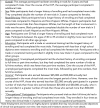Healthy volunteers in US phase I clinical trials: Sociodemographic characteristics and participation over time
- PMID: 34492044
- PMCID: PMC8423261
- DOI: 10.1371/journal.pone.0256994
Healthy volunteers in US phase I clinical trials: Sociodemographic characteristics and participation over time
Erratum in
-
Correction: Healthy volunteers in US phase I clinical trials: Sociodemographic characteristics and participation over time.PLoS One. 2022 Jan 26;17(1):e0263362. doi: 10.1371/journal.pone.0263362. eCollection 2022. PLoS One. 2022. PMID: 35081171 Free PMC article.
Abstract
Background: Increasing the diversity of research participants is an important focus of clinical trials. However, little is known regarding who enrolls as healthy volunteers in Phase I clinical trials, which test the safety and tolerability of investigational new drugs. Despite the risk, healthy volunteers can derive no medical benefit from their participation, and they are financially compensated for enrolling.
Objective: This study's purpose is to describe sociodemographic characteristics and clinical trial participation histories of healthy people who enroll in US Phase I trials.
Methods: The HealthyVOICES Project (HVP) is a longitudinal study of healthy individuals who have enrolled in Phase I trials. We describe self-reported sociodemographic information and Phase I trial history from HVP recruitment (May-December 2013) through the project's end three years later (December 2016). Trial experiences are presented as medians and quartiles.
Results: The HVP included 178 participants. Nearly three-fourths of participants were male, and two-thirds were classified as racial and ethnic minorities. We found that some groups of participants were more likely to have completed a greater number of clinical trials over a longer timeframe than others. Those groups included participants who were male, Black, Hispanic, 30-39-years-old, unemployed, had received vocational training in a trade, or had annual household incomes of less than $25,000. Additionally, the greater the number of clinical trials participants had completed, the more likely they were to continue screening for new trials over the course of three years. Participants who pursued clinical trials as a full-time job participated in the greatest number of trials and were the most likely to continuing screening over time.
Implications: Participation as a healthy volunteer in US Phase I trials is driven by social inequalities. Disadvantaged groups tend to participate in a greater number of clinical trials and participate longer than more privileged groups.
Conflict of interest statement
The authors have declared that no competing interests exist.
Figures



Similar articles
-
Phase I trial compensation: How much do healthy volunteers actually earn from clinical trial enrollment?Clin Trials. 2021 Aug;18(4):477-487. doi: 10.1177/17407745211011069. Epub 2021 May 2. Clin Trials. 2021. PMID: 33938244 Free PMC article.
-
Healthy volunteers' perceptions of risk in US Phase I clinical trials: A mixed-methods study.PLoS Med. 2018 Nov 20;15(11):e1002698. doi: 10.1371/journal.pmed.1002698. eCollection 2018 Nov. PLoS Med. 2018. PMID: 30457992 Free PMC article.
-
Challenging assumptions about minority participation in US clinical research.Am J Public Health. 2011 Dec;101(12):2217-22. doi: 10.2105/AJPH.2011.300279. Epub 2011 Oct 20. Am J Public Health. 2011. PMID: 22021285 Free PMC article.
-
Are racial and ethnic minorities less willing to participate in health research?PLoS Med. 2006 Feb;3(2):e19. doi: 10.1371/journal.pmed.0030019. Epub 2005 Dec 6. PLoS Med. 2006. PMID: 16318411 Free PMC article. Review.
-
Racial and Ethnic Disparities in Primary Open-Angle Glaucoma Clinical Trials: A Systematic Review and Meta-analysis.JAMA Netw Open. 2021 May 3;4(5):e218348. doi: 10.1001/jamanetworkopen.2021.8348. JAMA Netw Open. 2021. PMID: 34003274 Free PMC article.
Cited by
-
Diversity and Representation Among United States Participants in Amgen Clinical Trials.J Racial Ethn Health Disparities. 2024 Oct;11(5):3112-3127. doi: 10.1007/s40615-023-01768-2. Epub 2023 Sep 27. J Racial Ethn Health Disparities. 2024. PMID: 37755687 Free PMC article.
-
Factors that impact on recruitment to vaccine trials in the context of a pandemic or epidemic: a qualitative evidence synthesis.Cochrane Database Syst Rev. 2023 Sep 1;9(9):MR000065. doi: 10.1002/14651858.MR000065.pub2. Cochrane Database Syst Rev. 2023. PMID: 37655964 Free PMC article. Review.
-
Mutual Emotional Labor as Method: Building Connections of Care in Qualitative Research.Qual Rep. 2023 Nov;28(11):3192-3212. doi: 10.46743/2160-3715/2023.6251. Qual Rep. 2023. PMID: 39386316 Free PMC article.
-
Impact of financial compensation on enrollment and participation in a remote, mobile-app based research study.J Clin Transl Sci. 2024 Apr 5;8(1):e75. doi: 10.1017/cts.2024.515. eCollection 2024. J Clin Transl Sci. 2024. PMID: 38715567 Free PMC article.
-
Sociodemographic characteristics of healthy volunteers along with their experience, attitude and concerns of clinical trials in Wuhan, China.Sci Rep. 2023 Nov 9;13(1):19550. doi: 10.1038/s41598-023-46979-z. Sci Rep. 2023. PMID: 37945746 Free PMC article.
References
-
- Fisher JA. Adverse events: race, inequality, and the testing of new pharmaceuticals. New York: New York University Press; 2020.
Publication types
MeSH terms
Grants and funding
LinkOut - more resources
Full Text Sources

